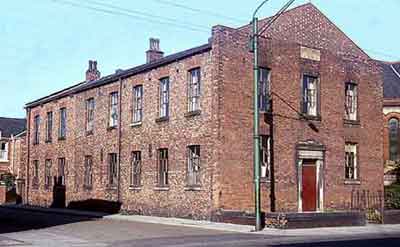Stockport Rd, Denton
The first Congregational Chapel in Denton was founded in 1836 at a cottage on Stockport Rd, opposite the market place, occupied by Betty Potter.
Several men from Ashton and Hyde took the services, including J Lord Tweedale, Abel Buckley and S B Tomlins of Ashton and W Sunderland and Samuel Bostock of Hyde.
Shortly afterwards a chapel was built on the corner of Stockport Rd and Duke St. On the 2 July 1836 the foundation stone of this chapel was laid by S B Tomlins, a banker of Ashton and it opened on the 16 November 1836.
On the 20 Nov 1837 the chapel was formally organised on Congregational principles. The first marriage to be solemnized at the chapel was on the 9 Mar 1841 when John Crompton married Ann Pearson nee Garside,
the Minister being the Rev. Thomas H Smith.
The two-storey chapel of 1836 was of brick construction, three bays wide by five bays deep. Services were conducted on the first floor and the ground floor contained classrooms. Sometime after 1877, another three bays were added to the rear to enable a full-size stage to be provided for the use of operatic and drama societies.

The foundation stone for the second chapel was laid on Stockport Rd, adjacent to the original chapel, on the 14 Apr 1876 and it opened on the 6 Sep 1877. The foundation stone was laid by Miss Bradbury of Southport assisted by Revd A Clark of Stockport, James O Lupton of Ashton-under-Lyne, Revd Thomas Green of Ashton-under-Lyne, John Mollady of Reddish and the Revd John Waddington who was then the Minister at the chapel.
The second chapel, which could seat around 700 persons, was of Byzantine architecture, executed in red bricks, with white ends for facings, cornices and some ornamental work. The portico was formed of three arches, supported by two stone columns, and ornamental lead work was used in making the round-headed window above the portico, which consisted of a central light flanked by two lights on each side. There was a gallery for members of the congregation and an organ gallery at the opposite end of the building. Below this, two vestries were provided and there was a basement in which the heating equipment was housed. All the woodwork was of pitch pine. The contractors were Messrs J Robinson & Son of Hyde, working under the direction of Messrs Salomons and Ely, architects, of Manchester, i.e. Edward Salomons and John Ely.
The residence of the incumbent minister was at Holland House on Manchester Rd near the entrance to Taylor Ln.

In 1966/67 the first chapel was demolished and replaced by a hall. Following the discovery of dry rot in the roof of the second chapel, it was demolished in 1974 and replaced by a third chapel that opened as Hope Church.
There was a graveyard, which was located between the first and second chapels, the last burial being in c.1910. In 1967 this was levelled to become part of a car park.
In 1972 the Congregational Church amalgamated with the English Presbyterian Church to become the United Reformed Church.